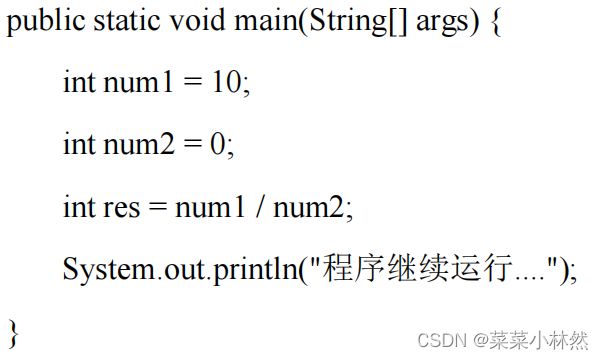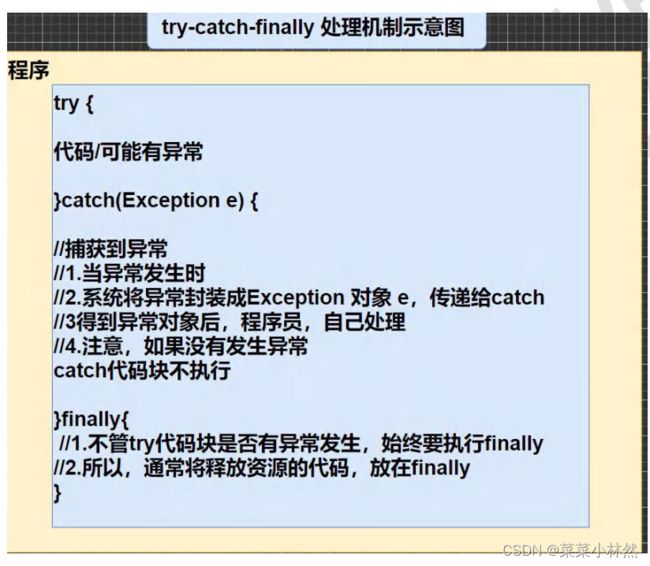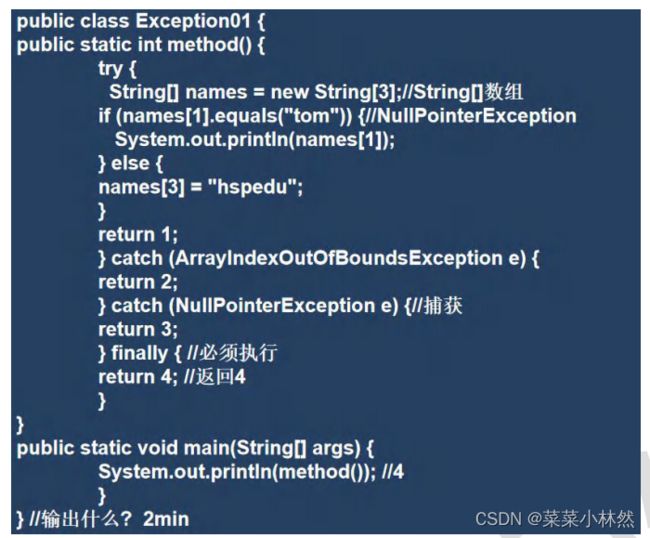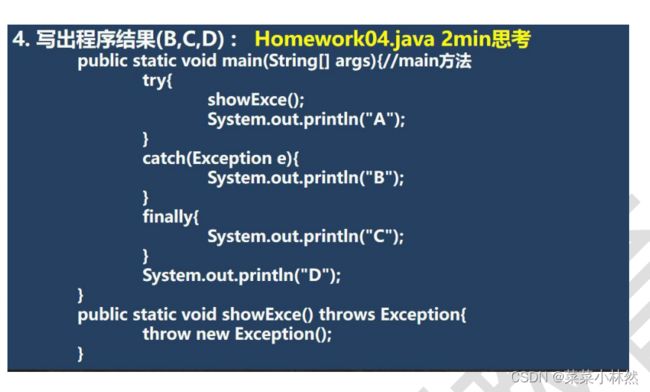0基础学java-day12-(异常-Exception)
一、异常
1 看个实际的问题和一段代码
运行下面的代码,看看有什么问题-> 引出异常和异常处理机制
2 解决方案-异常捕获
对异常进行捕获,保证程序可以继续运行 .
package com.hspedu.exception_;
/**
* @author 林然
* @version 1.0
*/
public class Exception01 {
public static void main(String[] args) {
int num1 = 10;
int num2 = 0;//Scanner();
//1. num1 / num2 => 10 / 0
//2. 当执行到 num1 / num2 因为 num2 = 0, 程序就会出现(抛出)异常 ArithmeticException
//3. 当抛出异常后,程序就退出,崩溃了 , 下面的代码就不在执行
//4. 大家想想这样的程序好吗? 不好,不应该出现了一个不算致命的问题,就导致整个系统崩溃
//5. java 设计者,提供了一个叫 异常处理机制来解决该问题
//如果程序员,认为一段代码可能出现异常/问题,可以使用 try-catch 异常处理机制来解决
//从而保证程序的健壮性
//将该代码块->选中->快捷键 ctrl + alt + t -> 选中 try-catch
//6. 如果进行异常处理,那么即使出现了异常,程序可以继续执行
try {
int res = num1 / num2;
} catch (Exception e) {
//e.printStackTrace();
System.out.println("输出异常信息"+e.getMessage());
}
System.out.println("程序继续运行....");
}
}
3 异常介绍
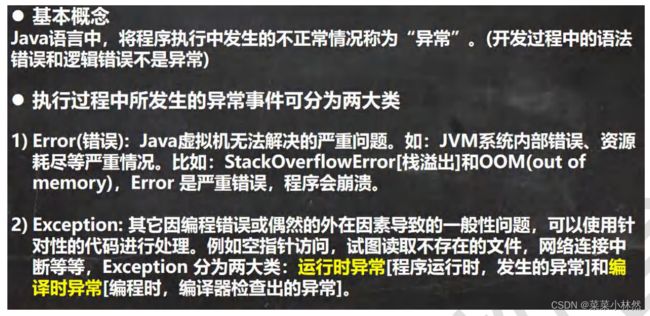 4 异常体系图一览
4 异常体系图一览
4.1 异常体系图 
4.2 异常体系图的小结
 5 常见的运行时异常
5 常见的运行时异常
5.1 常见的运行时异常包括
- NullPointerException 空指针异常
- ArithmeticException 数学运算异常
- ArrayIndexOutOfBoundsException 数组下标越界异常
- ClassCastException 类型转换异常
- NumberFormatException 数字格式不正确异常
5.2 常见的运行时异常举例
5.2.1 NullPointerException 空指针异常
当应用程序试图在需要对象的地方使用 null 时,抛出该异常 ,
package com.hspedu.exception_;
/**
* @author 林然
* @version 1.0
*/
public class NullPointerException_ {
public static void main(String[] args) {
String name =null;
System.out.println(name.length());
}
} 5.2.2 ArithmeticException 数学运算异常
5.2.2 ArithmeticException 数学运算异常
当出现异常的运算条件时,抛出此异常。例如,一个整数“除以零”时,抛出此类的一个实例
5.2.3 ArrayIndexOutOfBoundsException 数组下标越界异常
用非法索引访问数组时抛出的异常。如果索引为负或大于等于数组大小,则该索引为非法索引
package com.hspedu.exception_;
/**
* @author 林然
* @version 1.0
*/
public class ArrayIndexOutOfBoundsException_ {
public static void main(String[] args) {
int[] arr = {1,2,4};
for (int i = 0; i <= arr.length; i++) {
System.out.println(arr[i]);
}
}
}
5.2.4 ClassCastException 类型转换异常
当试图将对象强制转换为不是实例的子类时,抛出该异常
package com.hspedu.exception_;
/**
* @author 林然
* @version 1.0
*/
public class ClassCastException_ {
public static void main(String[] args) {
A b =new B();//向上转型
B b2 = (B)b;//向下转型
C c2 =(C)b;//这里抛出 ClassCastException
}
}
class A{}
class B extends A{}
class C extends A{}
5.2.5 NumberFormatException 数字格式不正确异常
当应用程序试图将字符串转换成一种数值类型,但该字符串不能转换为适当格式时,抛出该异常 => 使用异常我们 可以确保输入是满足条件数字
package com.hspedu.exception_;
/**
* @author 林然
* @version 1.0
*/
public class NumberFormatException_ {
public static void main(String[] args) {
String name ="林然";
//将 String 转成 int
int num = Integer.parseInt(name);//抛出 NumberFormatException
System.out.println(num);
}
}
6 编译异常
6.1 介绍
 6.2 常见的编译异常
6.2 常见的编译异常
 6.3 案例说明
6.3 案例说明
 7 异常课堂练习
7 异常课堂练习
看看下面代码是否正确,为什么? 【第2题的将第一行改为 Cat cat =new Cat()】
 8 异常处理
8 异常处理
8.1 基本介绍
 8.2 异常处理的方式
8.2 异常处理的方式
 8.3 示意图
8.3 示意图
9 try-catch 异常处理
9.1 try-catch 方式处理异常说明
 9.2 try-catch 方式处理异常-快速入门
9.2 try-catch 方式处理异常-快速入门
public static void main(String[] args) {
int num1 = 10;
int num2 = 0;//Scanner();
//1. num1 / num2 => 10 / 0
//2. 当执行到 num1 / num2 因为 num2 = 0, 程序就会出现(抛出)异常 ArithmeticException
//3. 当抛出异常后,程序就退出,崩溃了 , 下面的代码就不在执行
//4. 大家想想这样的程序好吗? 不好,不应该出现了一个不算致命的问题,就导致整个系统崩溃
//5. java 设计者,提供了一个叫 异常处理机制来解决该问题
//如果程序员,认为一段代码可能出现异常/问题,可以使用 try-catch 异常处理机制来解决
//从而保证程序的健壮性
//将该代码块->选中->快捷键 ctrl + alt + t -> 选中 try-catch
//6. 如果进行异常处理,那么即使出现了异常,程序可以继续执行
try {
int res = num1 / num2;
} catch (Exception e) {
//e.printStackTrace();
System.out.println("输出异常信息"+e.getMessage());
}
System.out.println("程序继续运行....");
}
.9.3 try-catch 方式处理异常-注意事项
package com.hspedu.exception_;
/**
* @author 林然
* @version 1.0
*/
public class TryCatchDetail {
public static void main(String[] args) {
//ctrl + atl + t
//1. 如果异常发生了,则异常发生后面的代码不会执行,直接进入到 catch 块
//2. 如果异常没有发生,则顺序执行 try 的代码块,不会进入到 catch
//3. 如果希望不管是否发生异常,都执行某段代码(比如关闭连接,释放资源等)则使用如下代码- finally
try {
String str = "林然";
int a = Integer.parseInt(str);
System.out.println("数字:" + a);
} catch (NumberFormatException e) {
System.out.println("异常信息=" + e.getMessage());
} finally {
System.out.println("finally 代码块被执行...");
}
System.out.println("程序继续...");
}
}
package com.hspedu.exception_;
/**
* @author 林然
* @version 1.0
*/
public class TryCatchDetail02 {
public static void main(String[] args) {
//1.如果 try 代码块有可能有多个异常
//2.可以使用多个 catch 分别捕获不同的异常,相应处理
//3.要求子类异常写在前面,父类异常写在后面
try {
Person person = new Person();
//person = null;
System.out.println(person.getName());//NullPointerException
int n1 = 10;
int n2 = 0;
int res = n1 / n2;//ArithmeticException
} catch (NullPointerException e) {
System.out.println("空指针异常=" + e.getMessage());
} catch (ArithmeticException e) {
System.out.println("算术异常=" + e.getMessage());
} catch (Exception e) {
System.out.println(e.getMessage());
} finally {
}
}
}
class Person {
private String name = "jack";
public String getName() {
return name;
}
}
package com.hspedu.exception_;
/**
* @author 林然
* @version 1.0
*/
public class TryCatchDetail03 {
public static void main(String[] args) {
try{
int n1 = 10;
int n2 = 0;
System.out.println(n1 / n2);
}finally {
System.out.println("执行了 finally..");
}
System.out.println("程序继续执行..");
}
}
9.4 异常处理课堂练习
1) 题 1 TryCatchExercise01.java 【由于finally必须执行,所以在catch中并不会返回3】
3) 题 3TryCatchExercise03.java【这题需要认真对待】
9.5 try-catch-finally 执行顺序小结
 9.6 课后练习题
9.6 课后练习题
如果用户输入的不是一个整数,就提示他反复输入,直到输入一个整数为止
package com.hspedu.try_;
import java.util.Scanner;
/**
* @author 林然
* @version 1.0
*/
public class TryCatchExercise04 {
//如果用户输入的不是一个整数,就提示他反复输入,直到输入一个整数为止
//思路
//1. 创建 Scanner 对象
//2. 使用无限循环,去接收一个输入
//3. 然后将该输入的值,转成一个 int
//4. 如果在转换时,抛出异常,说明输入的内容不是一个可以转成 int 的内容
//5. 如果没有抛出异常,则 break 该循环
public static void main(String[] args) {
Scanner sc =new Scanner(System.in);
int num = 0;
String inputstr =" ";
while (true){
System.out.println("晴输入一个整数:");
inputstr = sc.next();
try {
num = Integer.parseInt(inputstr);
break;
} catch (NumberFormatException e) {
System.out.println("输入的不是一个整数");
}
}
System.out.println("你输入的值是="+num);
}
}
10 throws 异常处理
10.1 基本介绍
 10.2 快速入门案例
10.2 快速入门案例
package com.hspedu.throws_;
import java.io.FileInputStream;
import java.io.FileNotFoundException;
/**
* @author 林然
* @version 1.0
*/
public class throws1 {
public static void main(String[] args) {
}
public void f1()throws FileNotFoundException,NullPointerException{
//创建文件流对象
//这里的异常是一个FileNotFoundException编译异常
//使用前面讲的try-catch-finally
//使用throws,抛出异常,让调用f2方法的调用者处理
//throws后面的异常类型可以是方法中产生的异常类型,也可以是他的父类
//throws关键字后也可以是异常列表
FileInputStream fis = new FileInputStream("d://aa.txt");
}
}
10.3 注意事项和使用细节
package com.hspedu.throws_;
import java.io.FileInputStream;
import java.io.FileNotFoundException;
/**
* @author 林然
* @version 1.0
*/
public class ThrowsDetail {
public static void main(String[] args) {
}
public static void f2()/*throws ArithmeticException*/{
//1.对于编译异常,程序中必须处理,比如 try-catch 或者 throws
//2.对于运行时异常,程序中如果没有处理,默认就是 throws 的方式处理
int n1 = 10;
int n2 = 0;
double res = n1 / n2;
}
public static void f1() throws FileNotFoundException {
//这里大家思考问题 调用 f3() 报错
//老韩解读
//1. 因为 f3() 方法抛出的是一个编译异常
//2. 即这时,就要 f1() 必须处理这个编译异常
//3. 在 f1() 中,要么 try-catch-finally ,或者继续 throws 这个编译异常
f3(); // 抛出异常
}
public static void f3() throws FileNotFoundException {
FileInputStream fis = new FileInputStream("d://aa.txt");
}
public static void f4() {
//老韩解读:
//1. 在 f4()中调用方法 f5() 是 OK
//2. 原因是 f5() 抛出的是运行异常
//3. 而 java 中,并不要求程序员显示处理,因为有默认处理机制
f5();
}
public static void f5() throws ArithmeticException {
}
}
class Father { //父类
public void method() throws RuntimeException {
}
}
class Son extends Father {//子类
//3. 子类重写父类的方法时,对抛出异常的规定:子类重写的方法,
// 所抛出的异常类型要么和父类抛出的异常一致,要么为父类抛出的异常类型的子类型
//4. 在 throws 过程中,如果有方法 try-catch , 就相当于处理异常,就可以不必 throws
@Override
public void method() throws ArithmeticException {
}
}
11自定义异常
11.1 基本概念
 11.2 自定义异常的步骤
11.2 自定义异常的步骤
 11.3 自定义异常的应用实例
11.3 自定义异常的应用实例
package com.hspedu.customexception_;
/**
* @author 林然
* @version 1.0
*/
public class CustomException {
public static void main(String[] args) {
int age = 180;
//要求范围在 18 – 120 之间,否则抛出一个自定义异常
if(!(age >= 18 && age <= 120)) {
//这里我们可以通过构造器,设置信息
throw new AgeException("年龄需要在 18~120 之间");
}
System.out.println("你的年龄范围正确.");
}
}
//自定义一个异常
//1. 一般情况下,我们自定义异常是继承 RuntimeException
//2. 即把自定义异常做成 运行时异常,好处时,我们可以使用默认的处理机制
//3. 即比较方便
class AgeException extends RuntimeException{
public AgeException(String message) {
super(message);
}
}12 throw 和 throws 的区别
12.1 一览表
 12.2 测试题-下面的测试输出什么
12.2 测试题-下面的测试输出什么
 13本章作业
13本章作业
13.1 作业一
package com.hspedu.homework;
/**
* @author 林然
* @version 1.0
*/
public class Homework01 {
public static void main(String[] args) {
/*
编写应用程序EcmDef.java,接收命令行的两个参数(整数),计算两数相除。
计算两个数相除,要求使用方法 cal(int n1, int n2)
对数据格式不正确(NumberFormatException)、缺少命令行参数(ArrayIndexOutOfBoundsException)、除0 进行异常处理(ArithmeticException)。
*/
try {
//先验证输入的参数的个数是否正确 两个参数
if(args.length != 2) {
throw new ArrayIndexOutOfBoundsException("参数个数不对");
}
//先把接收到的参数,转成整数
int n1 = Integer.parseInt(args[0]);
int n2 = Integer.parseInt(args[1]);
double res = cal(n1, n2);//该方法可能抛出ArithmeticException
System.out.println("计算结果是=" + res);
} catch (ArrayIndexOutOfBoundsException e) {
System.out.println(e.getMessage());
} catch (NumberFormatException e) {
System.out.println("参数格式不正确,需要输出整数");
} catch (ArithmeticException e) {
System.out.println("出现了除0的异常");
}
}
//编写cal方法,就是两个数的商
public static double cal(int n1, int n2) {
return n1 / n2;
}
}
